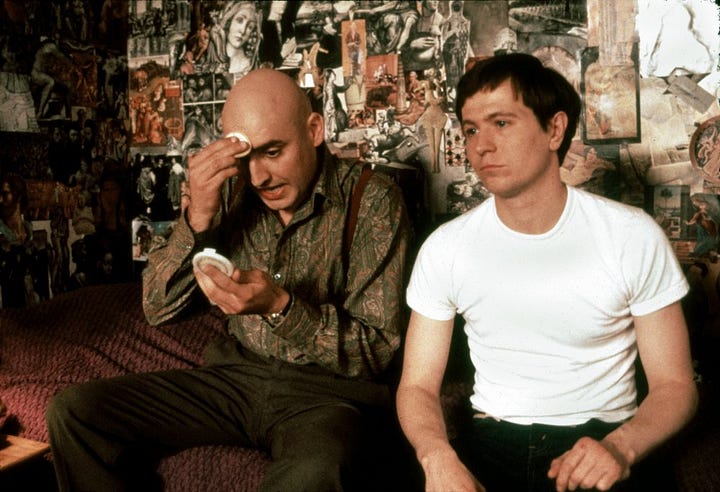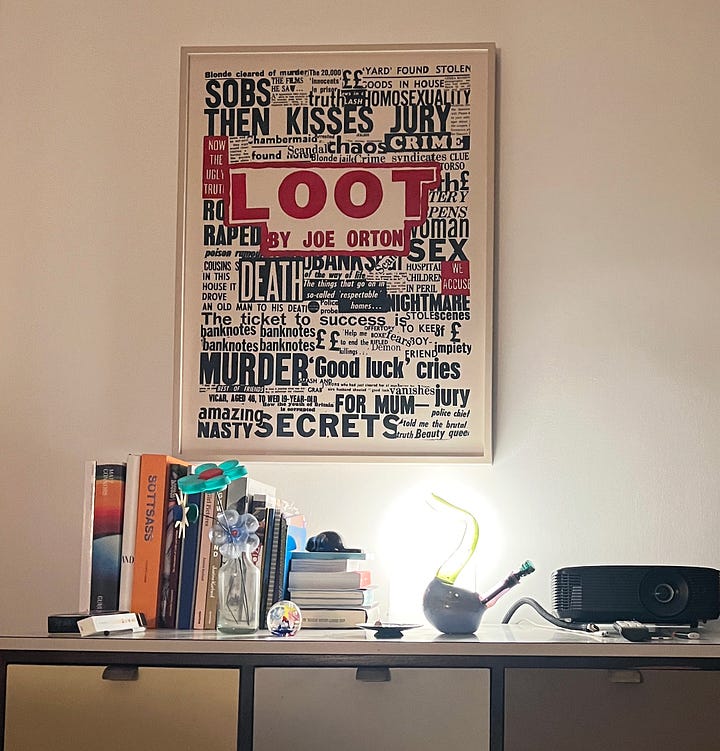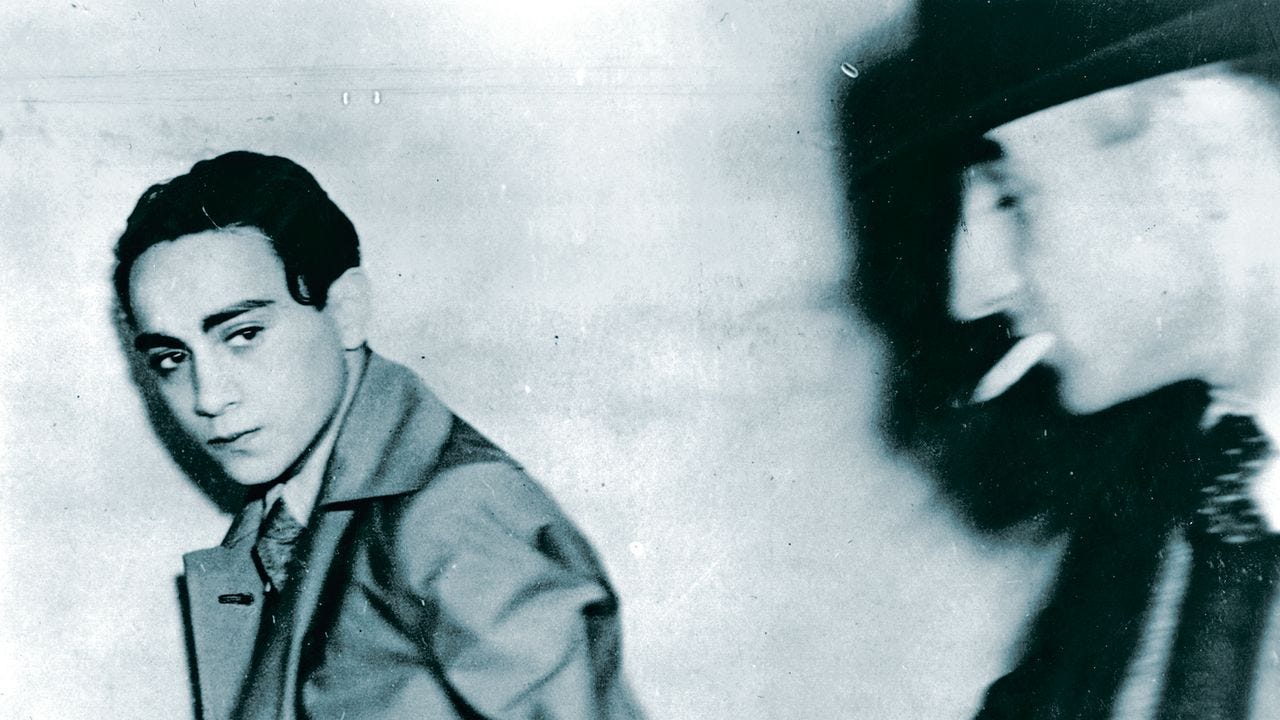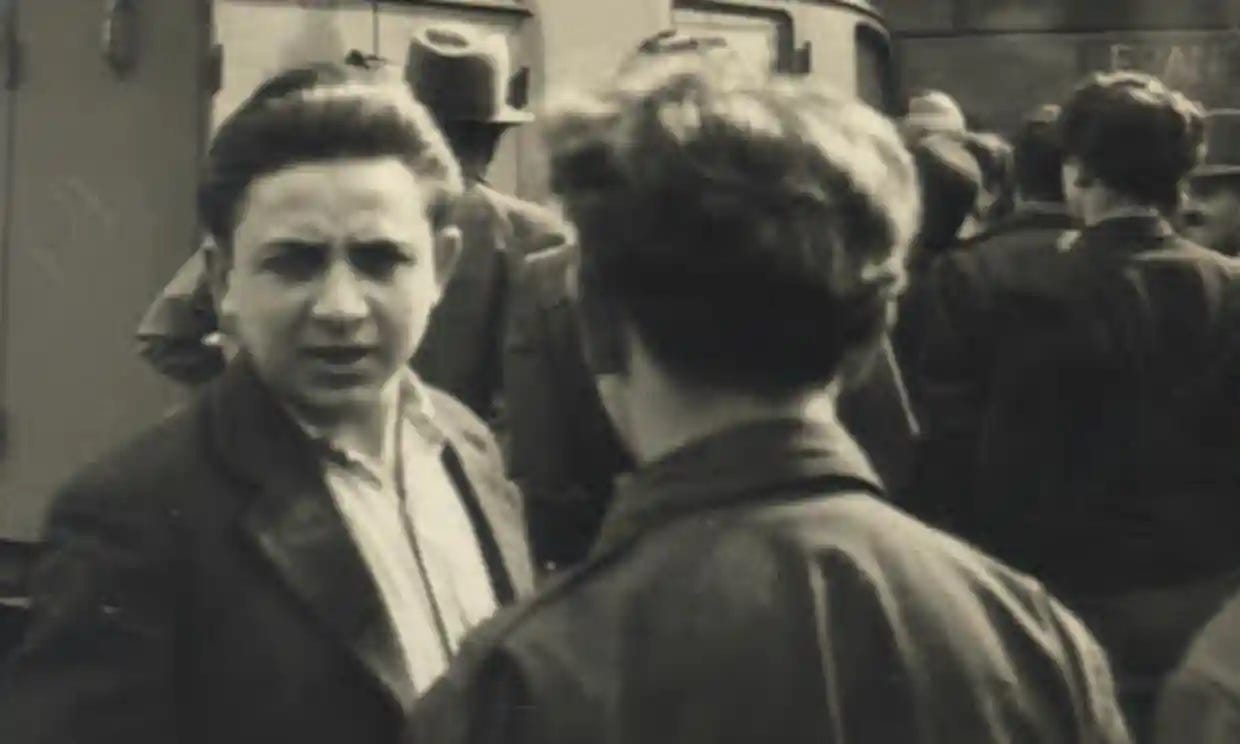Every documentary filmmaker gets asked if they want to make a narrative feature film. I speculate most do, but I can say with some confidence that I do not. When I was younger, I thought that’s what you’re supposed to do, that fiction is the holy grail. I came up with lots of ideas, but my best was a TV show based on Sassy Magazine. But after making my third film, I recognized that I love doing what I do. The process I use more or less works for me, and if that feeling isn’t fading, why fuck with it? But I know so many talented people who feel like they’re doing the wrong thing, or think that some alternative creative path will yield more credibility, fulfillment, or success. It’s the Joni Mitchell painting effect.


There’s just one narrative film that I watch every few years, which makes me think, “I wish I had made that.” It’s Stephen Frears’ Prick Up Your Ears from 1987. The film is about a BBC documentary filmmaker making a film about the playwright Joe Orton. I love the documentary conceit, but even more so I love seeing that particular mid-1960s London queer milieu, when gay people spoke the underground Polari slang that’s the namesake of this substack. Joe’s boyfriend Kenneth Halliwell was the older, homely brains behind Joe’s public-facing sexy playwright persona. I won’t spoil the ending, but it’s not happy.
I first learned about Joe and Kenneth’s story when I came across a beautiful (and sadly) out-of-print book published by Donlon Books called Malicious Damage. In 1962, Joe and Kenneth stole images from hundreds of Islington library books, cut them out and made an immersive, obsessive collage on their apartment walls. Sometimes they replaced the stolen library books with mischievous and queer collaged covers. When they got caught, each served six months in prison for “larceny, malicious and willful damage.” In Prick Up Your Ears, there’s a facsimile of an amazing poster that Kenneth collaged for Joe’s most celebrated play Loot. I called up the Orton archives, licensed a photo of the original poster for five dollars, and Carl made a silkscreen version for our house. (The overachiever fan art is illustrated above.)
All this to say, that’s the fiction film I would want to make, but somebody already did it very well in the 1980s, so I don’t have to. But in the spirit of oversharing ideas, here is a film I want to make, but can’t wrap my brain around how. Please don’t steal the idea, and if you do you’ll be haunted.
Herschel Grynszpan
I came across Herschel’s story on the recommendation of my friend and collaborator, Jon Savage, who knows all things punk, youth culture, and gay. The story goes that the Grynszpans were tailors in a cloistered Polish Orthodox community in Hanover, Germany. When the Nazi party came to power, they sent their 15-year-old son, Herschel, to live with his aunt and uncle in Paris. Herschel was a loner dressed by his father like Rudolph Valentino. He was often seen traipsing through Parisian cinemas and coffee houses, and was known as the “Yiddish poet of the streets.”
By October of 1938, the Grynszpans and their Jewish community were being herded by the Gestapo onto trains heading for Poland. When Herschel’s sister wrote with pleas for help, he swiped 300 francs from his uncle, bought a pocket handgun, and walked into the German embassy to deliver “an important document.” As Ambassador Ernst vom Rath emerged, Herschel opened fire, screaming, “In the name of 12,000 persecuted Jews, here is the document!”
That night after Raft was pronounced dead, on the recommendation of Hitler, Goebbels made a notorious speech in Munich, imploring Germans to make the Jews “feel the people’s fury.” With Herschel as their pretext, anti-semitic rioters destroyed 267 synagogues, murdered 91 Jews, and rounded up 30,000 more for concentration camps. This is known as Kristallnacht, widely understood as the defining prelude to the Holocaust.
After the horrors of Kristallnacht, Grynszpan became a cause célèbre. He was interviewed by journalists from his prison cell and swapped fan mail with movie stars. The American Jewish intelligentsia raised funds for a top tier (and strategically gentile) legal team. Emboldened, Herschel pressed his team to pursue the “Jewish avenger” defense.
But when he finally took the stand at the trial, Herschel made the most spectacular fuck you of all fuck you moves: He recounted his prolonged homosexual love affair with the ambassador, and said that when Rath refused his request for French citizenship, he committed a crime of passion. Safe to say, neither the Nazis nor the burgeoning Jewish resistance wanted Herschel as their political poster child anymore, and the trial was canceled.
What happened next is a mystery. It’s assumed that Nazis murdered Herschel in 1942. His parents miraculously survived the Holocaust and moved to Israel. They petitioned to pronounce Herschel dead in 1960 to draw a pension from the German state. Then get this— in 2016 a photograph of 24-year-old Herschel was discovered at a 1946 gathering of displaced people. Herschel may have survived and lived in Israel or the United States under an assumed name, slipping into the back row of movie theaters, or reading his favorite Yiddish poetry at an old people’s home in Yonkers. He would be 102-years-old today.
Pretty fucking great story, and extremely up my alley. Here’s what I’m basically scouring the world for at all times: 1. A hidden history that touches upon something very well known (the Holocaust), but from a completely unexpected angle. 2. A gay anti-hero, who doesn’t conform to respectability politics and can’t be categorized. 3. An archival mystery: some sort of cache of rare or forgotten footage, or in this case, a photograph that destabilizes the historical record, and lays the groundwork for a biographical fantasy. Let me know if you find something that fits the bill, it’s not easy.
Another thing I’m realizing is that I love a story about someone, or a group of people who aren’t palatable to the mainstream, but nonetheless find themselves thrust into that spotlight. It’s interesting to think about both the opportunities and the consequences of visibility. We don’t know if Herschel was gay or not, but he weaponized his sexuality to release himself from the burden of political martyrdom and monstrosity. He was too much of a punk and outlier to be anybody’s symbol.
Am I really going to direct an elaborate period courtroom drama about the Holocaust? No. I guess I could make something like Woody Allen’s Zellig with fabricated newsreel footage of the whole saga, but that doesn’t seem particularly appealing to me. I talked to one of my favorite collaborators, David, about making an animated documentary version, and then I texted Jenna and Collier, “I’m making a Holocaust cartoon, for real!” But I was told by my confidantes and trusted ears to the ground (aka my Jewish agent, Amanda) that there isn’t currently an appetite for historical Nazi-era animated documentaries… Sigh.
There are some good fiction films being made by documentary filmmakers. The most recent is Alice Diop’s Saint Omer, which draws upon real events and courtroom testimony, and is brought to life by a riveting performance from Guslagie Malanda. I was so starstruck by her at a recent event that I asked her if she was Belgian, she looked at me funny, and I walked away.






